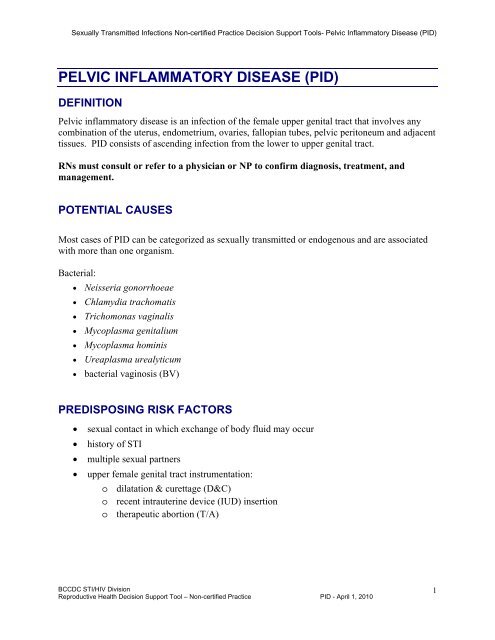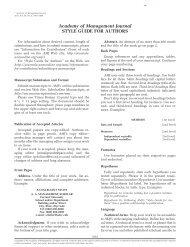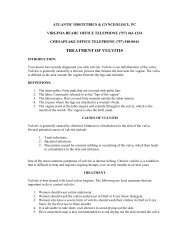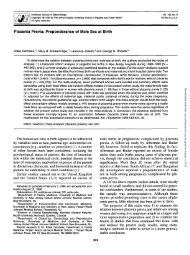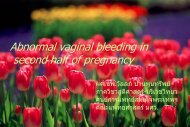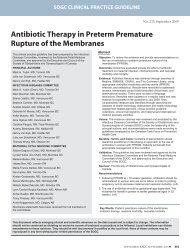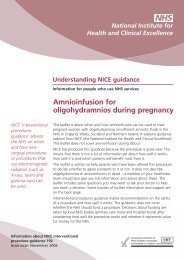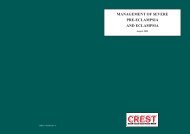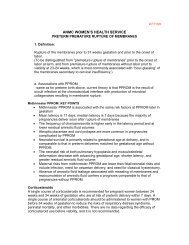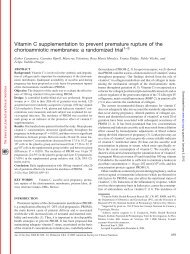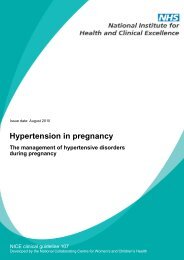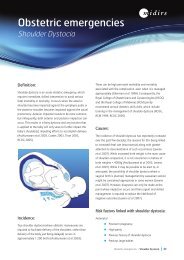PELVIC INFLAMMATORY DISEASE (PID)
PELVIC INFLAMMATORY DISEASE (PID)
PELVIC INFLAMMATORY DISEASE (PID)
You also want an ePaper? Increase the reach of your titles
YUMPU automatically turns print PDFs into web optimized ePapers that Google loves.
Sexually Transmitted Infections Non-certified Practice Decision Support Tools- Pelvic Inflammatory Disease (<strong>PID</strong>)<br />
<strong>PELVIC</strong> <strong>INFLAMMATORY</strong> <strong>DISEASE</strong> (<strong>PID</strong>)<br />
DEFINITION<br />
Pelvic inflammatory disease is an infection of the female upper genital tract that involves any<br />
combination of the uterus, endometrium, ovaries, fallopian tubes, pelvic peritoneum and adjacent<br />
tissues. <strong>PID</strong> consists of ascending infection from the lower to upper genital tract.<br />
RNs must consult or refer to a physician or NP to confirm diagnosis, treatment, and<br />
management.<br />
POTENTIAL CAUSES<br />
Most cases of <strong>PID</strong> can be categorized as sexually transmitted or endogenous and are associated<br />
with more than one organism.<br />
Bacterial:<br />
Neisseria gonorrhoeae<br />
Chlamydia trachomatis<br />
Trichomonas vaginalis<br />
Mycoplasma genitalium<br />
Mycoplasma hominis<br />
Ureaplasma urealyticum<br />
bacterial vaginosis (BV)<br />
PREDISPOSING RISK FACTORS<br />
<br />
<br />
<br />
<br />
sexual contact in which exchange of body fluid may occur<br />
history of STI<br />
multiple sexual partners<br />
upper female genital tract instrumentation:<br />
o dilatation & curettage (D&C)<br />
o recent intrauterine device (IUD) insertion<br />
o therapeutic abortion (T/A)<br />
BCCDC STI/HIV Division<br />
Reproductive Health Decision Support Tool – Non-certified Practice <strong>PID</strong> - April 1, 2010<br />
1
Sexually Transmitted Infections Non-certified Practice Decision Support Tools- Pelvic Inflammatory Disease (<strong>PID</strong>)<br />
TYPICAL FINDINGS<br />
Sexual Health History<br />
<br />
<br />
unprotected sexual contact with at least one partner<br />
recent IUD insertion or upper genital tract instrumentation<br />
PHYSICAL ASSESSMENT FINDINGS<br />
Cardinal Signs<br />
<br />
<br />
lower abdominal pain – usually bilateral<br />
abnormal bimanual pelvic exam that includes:<br />
o adenexal tenderness<br />
o fundal tenderness<br />
o cervical motion tenderness<br />
Additional Signs & Symptoms<br />
<br />
<br />
<br />
<br />
<br />
<br />
<br />
<br />
fever >38ºC<br />
dyspareunia<br />
abnormal vaginal bleeding or spotting<br />
abnormal vaginal discharge<br />
urinary frequency<br />
pelvic pain<br />
nausea or vomiting<br />
low back pain<br />
Differential Diagnosis:<br />
It is important to rule out other potential causes of lower abdominal pain including ectopic<br />
pregnancy, ovarian cysts, and gastrointestinal causes including appendicitis.<br />
BCCDC STI/HIV Division<br />
Reproductive Health Decision Support Tool – Non-certified Practice <strong>PID</strong> - April 1, 2010<br />
2<br />
prgmea.com
Sexually Transmitted Infections Non-certified Practice Decision Support Tools- Pelvic Inflammatory Disease (<strong>PID</strong>)<br />
DIAGNOSTIC TESTS:<br />
cervical swab for NAAT (GC/CT)<br />
AND<br />
cervical swab for GC culture & sensitivity<br />
AND<br />
urine pregnancy test<br />
AND<br />
vaginal swabs<br />
vaginal slide smear for trichomonas, yeast, and bacterial vaginosis<br />
swab for KOH whiff test<br />
vaginal pH<br />
AND<br />
bimanual exam for tenderness<br />
CLINICAL EVALUATION<br />
Clients who present with suspected <strong>PID</strong> as defined by pelvic tenderness and lower abdominal<br />
pain during the bimanual exam require referral to physician/NP to confirm the diagnosis prior to<br />
receiving treatment.<br />
MANAGEMENT AND INTERVENTIONS<br />
Goals of Treatment:<br />
<br />
<br />
<br />
<br />
<br />
commence rapid treatment to preserve fertility<br />
treat infection<br />
alleviate symptoms<br />
prevent further complications<br />
prevent spread of infection<br />
NOTE: If an IUD is present, the device should NOT BE REMOVED until after antibiotic<br />
therapy has been initiated and at least 2 doses of antibiotics have been taken.<br />
BCCDC STI/HIV Division<br />
Reproductive Health Decision Support Tool – Non-certified Practice <strong>PID</strong> - April 1, 2010<br />
3<br />
prgmea.com
Sexually Transmitted Infections Non-certified Practice Decision Support Tools- Pelvic Inflammatory Disease (<strong>PID</strong>)<br />
Criteria for Potential Hospitalization:<br />
The following criteria may indicate the need for hospitalization or parenteral therapy:<br />
<br />
<br />
<br />
surgical emergencies such as appendicitis or ectopic pregnancy that cannot be excluded<br />
client is pregnant<br />
client cannot tolerate oral treatments<br />
client is under the age of 19<br />
<br />
<br />
<br />
<br />
<br />
client has severe abdominal pain<br />
client has abdominal guarding, rigidity, or rebound tenderness<br />
client has severe nausea, vomiting, or a fever >38.5ºC<br />
client has underlying chronic illnesses such as diabetes, HIV or active Hepatitis infection<br />
concerns with the client’s ability to complete oral antibiotic therapy that may require<br />
parenteral treatment<br />
TREATMENT OF CHOICE - USE ONLY IN CONSULT WITH PHYSICIAN<br />
OR NP<br />
First Choice – <strong>PID</strong> Treatment without concurrent BV<br />
Cefixime 800mg po in a single dose AND doxycyline 100 mg PO BID for 10 days<br />
If BV is clinically diagnosed in the presence of <strong>PID</strong> then treatment for BV is added to the<br />
cefixime and doxycyline regime:<br />
First Choice – <strong>PID</strong> Treatment with concurrent BV<br />
Cefixime 800mg po in a single dose AND doxycyline 100 mg po bid for 10 days AND<br />
metronidazole 500 mg po bid for 10 days<br />
Note:<br />
1. Treatment for <strong>PID</strong> covers possibility of infection by chlamydia and gonorrhea;<br />
2. It is important for clients to abstain from sexual contact for 10 days after starting<br />
treatment until all partners have completed treatment;<br />
3. Do not use cefixime if allergic to cephalosporins or penicillin.<br />
4. Do not use doxyclycline if allergic to tetracycline<br />
BCCDC STI/HIV Division<br />
Reproductive Health Decision Support Tool – Non-certified Practice <strong>PID</strong> - April 1, 2010<br />
4<br />
prgmea.com
Sexually Transmitted Infections Non-certified Practice Decision Support Tools- Pelvic Inflammatory Disease (<strong>PID</strong>)<br />
ALTERNATE TREATMENT - USE ONLY IN CONSULT WITH<br />
PHYSICIAN OR NP<br />
Second Choice - <strong>PID</strong> Treatment without concurrent BV<br />
Cefixime 800mg po in a single dose AND Azithromycin 1 gm po in a single dose<br />
If BV is clinically diagnosed in the presence of <strong>PID</strong> then treatment for BV is added to the<br />
cefixime and azithromycin regime:<br />
Second Choice - <strong>PID</strong> Treatment with concurrent BV<br />
Cefixime 800mg po in a single dose AND Azithromycin 1 gm po in a single dose<br />
AND metronidazole 500 mg po bid for 10 days<br />
NOTE: Clients who receive Azithromycin as alternate treatment may require repeat treatment<br />
(Azithromycin 1 gm po in a single dose) at the follow-up visit. This decision is made in<br />
consultation with the physician/NP.<br />
TREATMENT OF CONTACT(S) TO <strong>PID</strong><br />
Treat and offer screening to all sexual contacts within the past 60 days. See treatment of contacts<br />
DST for treatment regime.<br />
PREGNANT OR BREASTFEEDING WOMEN<br />
Refer all pregnant or breastfeeding women to a physician or NP.<br />
PARTNER COUNSELLING AND REFERRAL<br />
Counsel clients to notify sexual contacts within the previous 60 days that they require testing and<br />
treatment to cover uncomplicated chlamydia and gonorrhea.<br />
Commence formal follow-up and partner notification processes if any reportable infections are<br />
diagnosed from the laboratory submitted specimens.<br />
MONITORING AND FOLLOW-UP<br />
Clients treated for <strong>PID</strong> should return to clinic for repeat assessment (bimanual exam) to ensure<br />
pelvic tenderness is resolving 2–3 days after the onset of treatment and again 4–7 days after<br />
treatment is completed.<br />
BCCDC STI/HIV Division<br />
Reproductive Health Decision Support Tool – Non-certified Practice <strong>PID</strong> - April 1, 2010<br />
5<br />
prgmea.com
Sexually Transmitted Infections Non-certified Practice Decision Support Tools- Pelvic Inflammatory Disease (<strong>PID</strong>)<br />
POTENTIAL COMPLICATIONS<br />
<br />
<br />
<br />
<br />
<br />
<br />
Fitz-Hugh-Curtis syndrome<br />
tubo-ovarian abcess<br />
ectopic pregnancy<br />
chronic pelvic pain<br />
tubal factor infertility<br />
recurrent <strong>PID</strong><br />
CLIENT EDUCATION /DISCHARGE INFORMATION<br />
Counsel client:<br />
<br />
<br />
<br />
<br />
<br />
<br />
<br />
<br />
<br />
to return for follow up assessment for pelvic tenderness in 48 to 72 hours after first visit<br />
and 4 to 7 days after treatment is finished<br />
regarding the importance of revisiting health care provider if symptoms worsen or persist<br />
regarding the appropriate use of medications (dosage, side effects, and need for retreatment<br />
if dosage not completed)<br />
to avoid sexual contact with current partners until they and partners have completed<br />
screening and treatment<br />
to inform last sexual contact and all sexual contacts within the last 60 days that they<br />
require testing and treatment<br />
regarding harm reduction measures (condom use)<br />
regarding the complications from untreated <strong>PID</strong><br />
regarding the risk of co infection risk for HIV when another STI is present<br />
the asymptomatic nature of STI and HIV<br />
CONSULTATION OR REFERRAL<br />
<br />
<br />
Refer/consult for all clients who present clinically with suspected <strong>PID</strong> to physician/NP<br />
Refer to physician/NP for clients who are experiencing persistent and/or worsening<br />
symptoms after treatment has been initiated<br />
BCCDC STI/HIV Division<br />
Reproductive Health Decision Support Tool – Non-certified Practice <strong>PID</strong> - April 1, 2010<br />
6
Sexually Transmitted Infections Non-certified Practice Decision Support Tools- Pelvic Inflammatory Disease (<strong>PID</strong>)<br />
DOCUMENTATION<br />
<br />
<br />
<br />
<strong>PID</strong> is not reportable<br />
institute reporting and partner notification processes if lab reportable infections are<br />
confirmed from diagnostic tests<br />
Document as per agency guidelines<br />
REFERENCES<br />
Altunyurt, S., Demir, N., Posaci, C. (2003). A randomized controlled trial of coil removal prior<br />
to treatment of pelvic inflammatory disease. European Journal of Obsterics & Gynecology and<br />
Reproductive Biology 107(2003) p. 81-84.<br />
BCCDC (2007) British Columbia Treatment Guidelines. Sexually Transmitted Infections in<br />
Adolescent and Adults. STI/HIV Prevention and Control Division, BC Centre for Disease Control.<br />
Haggerty, C., Hillier, S., Bass, D., Ness, R. (2004). Bacterial vaginosis and anaerobic bacteria<br />
are associated with endometritis. Clinical Infectious Disease 39 p. 990-995.<br />
Hillis, S., Joesoef, R., Marchbanks, P., Wasserheit, J., Cates, W., Westrom, L. (1993). Delayed<br />
care of pelvic inflammatory disease as a risk facto for impaired fertility. American Journal of Obstetrics<br />
and Gynecology 168(5) p. 1503-1509.<br />
Holmes, K., Sparling, P., Stamm, W., Piot, P., Wasserheit, J., Corey, L., Cohen, M., Watts, H.<br />
(2008). Sexually transmitted disease (4 th ed). Toronto, ON: McGraw Hill Medical.<br />
Ness, R., Trautmann, G., Richter, H., Randall, H., Peipert, J., Nelson, D., Schubeck, D.,<br />
McNeeley, S., Trout, W., Bass, D., Soper, D. (2005). Effectiveness of treatment strategies of some<br />
women with pelvic inflammatory disease: A randomized trial. Obstetrics & Geynecology 106(3) p. 573-<br />
580.<br />
Public Health Agency of Canada. (2006). Canadian Guidelines on Sexually Transmitted<br />
Infections. (updated January 2008). Retrieved from http://www.phac-aspc.gc.ca/std-mts/sti-its/indexeng.php<br />
Public Health Agency of Canada. (2008) Pelvic inflammatory disease. Canadian Guidelines on<br />
Sexually Transmitted Infections. Retrieved from<br />
www.phac-aspc.gc.ca/std-mts/sti_2006/pdf/pid06_e.pdf<br />
Ross, J., Judlin, P., Nilas, L. (2008 update). European guideline for the management of pelvic<br />
inflammatory disease. <strong>PID</strong> Treatment Guidelines. Retrieved from<br />
www.iusti.org/regions/europe/<strong>PID</strong>_v5.pdf<br />
Short, V., Totten, P., Ness, R., Astete, S., Kelsey, S., Haggerty, C. (2009). Clinical presentation<br />
of Mycoplasma genitalium infection versus Nesisseria gonorrhoeae infection among women with pelvic<br />
inflammatory disease. Clinical Infectious Disease 48 p. 41-47.<br />
Simms, I., Eastick, K., Mallinson, H., Thomas, K., Gokhale, R., Hay, P., Herring, A., Rogers, P.<br />
(2003). Associations between Mycoplasma genitalium, Chamydia trachomatis, and pelvic inflammatory<br />
disease. Sexually Transmitted Infections 79 p. 154-156.<br />
Trautmann, G., Kip, K., Richter, H., Soper, Dl, Peipert, J., Nelson, D., Trout, W., Schubeck, D.,<br />
Bass, D., Ness, R. (2008). Do short-term markers of treatment efficacy predict long-term sequelae of<br />
pelvic inflammatory disease? American Journal of Obstetrics & Gynecology. 30e1-e7.<br />
BCCDC STI/HIV Division<br />
Reproductive Health Decision Support Tool – Non-certified Practice <strong>PID</strong> - April 1, 2010<br />
7


